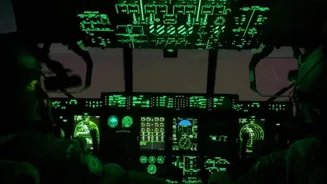What is the story about?
A Royal New Zealand Air Force (RNZAF) flight crew has successfully completed a 19‑hour mission to evacuate three staff members from the US McMurdo Station
in Antarctica. The crew battled extreme cold, shifting weather and 24‑hour darkness to land on ice and extract the patients, one of whom required urgent medical care, according to an RNZAF statement on Wednesday. The flight is among the “most challenging” Antarctic missions undertaken by RNZAF. Such operations are conducted only after a thorough analysis of weather and ice runway conditions, as there are no alternate airfields once the aircraft crosses into deep southern latitudes.
Landing on Ice in Complete Darkness
To make the rescue possible, the US Antarctic Program winter team at McMurdo physically prepared and groomed the runway to ensure it could support a landing. Crews flew using night‑vision goggles in pitch‑black conditions, a necessity during Antarctica’s winter months when the sun never rises. “These missions are not taken lightly,” the RNZAF release said, noting the high stakes if conditions deteriorate en route.
The flight departed Tuesday afternoon and carried a doctor on board to provide care to the patients during the return leg. By early Wednesday, the crew had safely landed in Christchurch, New Zealand, where the evacuees were transferred to a medical facility.
Medical Details Withheld, Focus on Safety
Authorities have not disclosed the nature of the medical emergencies but confirmed that one case was critical enough to warrant immediate evacuation. The mission underscores the difficulty of providing medical support in one of the harshest and most isolated environments on Earth.
According to the US National Science Foundation, McMurdo Station is the central logistical hub of the US Antarctic Program, supporting research on the frozen continent. The base typically houses around 1,000 people during summer and about 200 during winter, when flights are rare and highly weather‑dependent.
Missions Require Precision Planning
Former RNZAF personnel have described similar Antarctic operations as “no‑turn‑back missions,” requiring meticulous preparation and coordination between US and New Zealand teams. Pilots and flight engineers must calculate fuel reserves and factor in the lack of diversion options. The aircraft must also carry specialised survival gear in case of an emergency landing on ice.
RNZAF officials emphasised that every mid‑winter evacuation is evaluated against major risks to crew and passengers. “The crew can only attempt the flight after a detailed analysis of the weather and airfield state,” the release explained. “The United States Antarctic Program Winter Team must physically create the runway before we can depart by ensuring the ice is groomed and suitable for landing.”
Patients Arrive Safely in New Zealand
The three evacuated personnel are now receiving medical treatment in Christchurch. Their identities and conditions have not been released to protect privacy. The RNZAF praised the cooperation of US support teams and ground crews who made the runway safe for landing.
The mission highlights the critical role of New Zealand’s military aviation in supporting US research operations in Antarctica. With conditions expected to grow more volatile due to climate change impacting polar weather patterns, such missions are likely to remain rare but essential lifelines.
Do you find this article useful?















